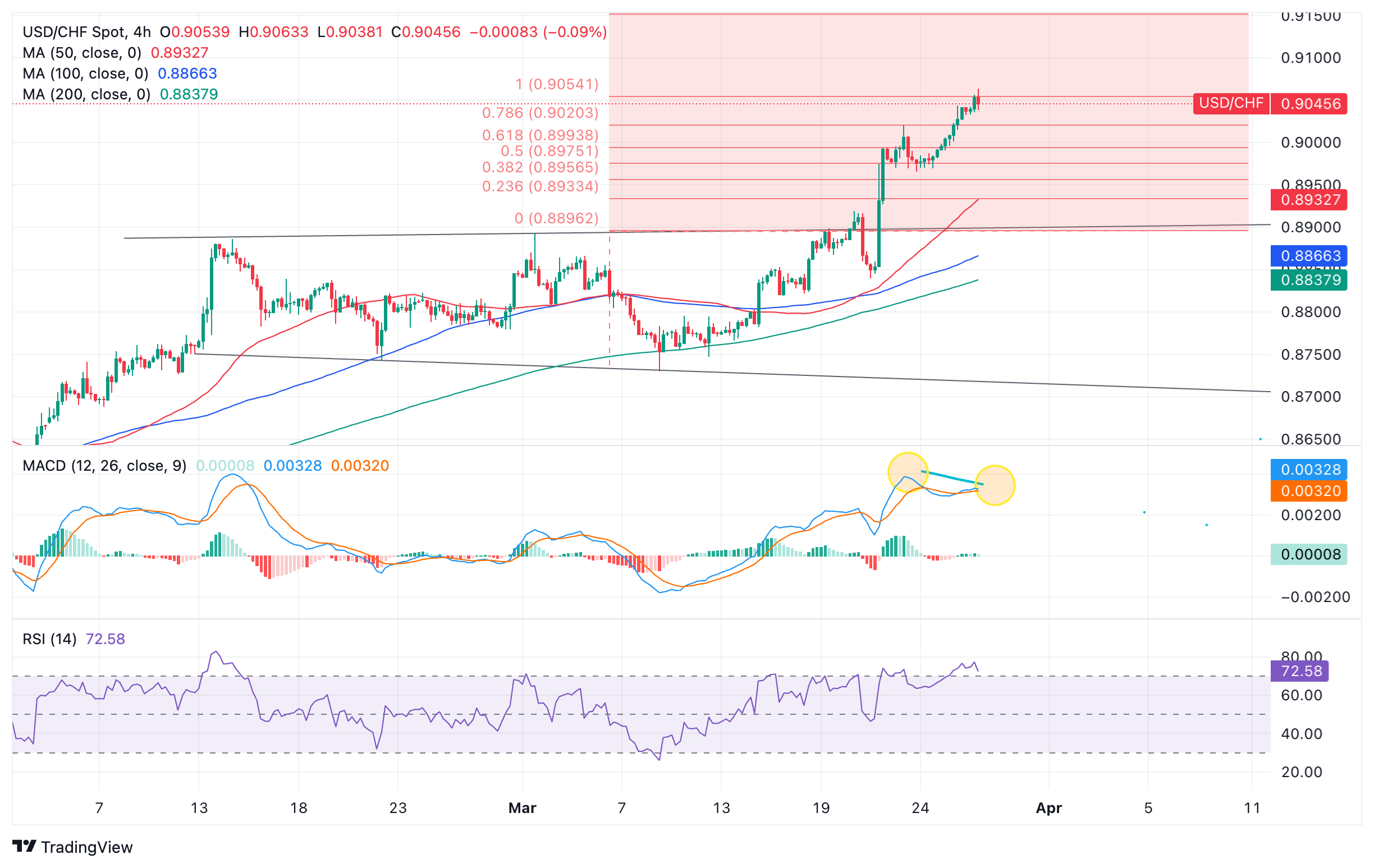Swiss Franc rises after positive survey data
- The Swiss Franc gains after the ZEW survey shows Swiss investors are optimistic about the economic outlook.
- The survey showed an increase in sentiment for the second month in a row.
- USD/CHF hits a key upside target and rolls over – potentially initiating a pullback.
The Swiss Franc (CHF) is trading higher in most key pairs on Wednesday, after the release of a Swiss investor survey showed upbeat responses regarding the outlook for the Swiss economy for the second month in a row.
Swiss Franc gets boost after investor survey reflects optimism
The Swiss Franc is rising midweek after the release of the Swiss ZEW Survey – Expectations for March, which showed investors were, on balance, positive in their responses, by a margin of 11.5, up from 10.2 in February.
The result marks the second positive month in a row after results fell and remained below zero in March 2022. The survey is thought to reflect investors’ optimism following the 0.25% reduction in interest rates by the Swiss National Bank (SNB) at its March meeting, according to Tradingeconomics.com.
Swiss ZEW Survey – Expectations: 5-year chart
Technical Analysis: Swiss Franc meets first target for breakout and pulls back
USD/CHF – the number of Swiss Francs that can be bought with one US Dollar (USD) – broke above the key 0.9000 level and reached a peak of 0.9063 on Wednesday, before rolling over.
The pair looks like it may be pulling back within an established short-term uptrend, which began after USD/CHF broke out of the range it had been trading in for most February and the first half of March.
US Dollar versus Swiss Franc: 4-hour chart
The pair has just reached the target of the range breakout at around 0.9050, calculated by taking the full height of the range and extrapolating it higher.
Since achieving the price objective, there is a risk the pair could correct lower. The Moving Average Convergence/ Divergence (MACD) indicator is showing bearish divergence with price at the recent peak when compared with the March 22 peak.
Although price continued rising, the MACD failed to. This is a sign of underlying weakness (circled).
The Relative Strength Index (RSI), another indicator, is sitting in overbought which is a sign traders should not add to their bullish bets. If it comes down and exits overbought it will be a signal to close bullish bets and short the pair.
If a pullback extends lower, it will probably first fall to support at the March 22 highs and the last higher high at 0.9020.
Beyond that, the pair is overall seen continuing the short-term uptrend that formed prior to the range and its breakout higher.
It would take a deeper slide below 0.8960 to bring into question the dominance of the uptrend and suggest the possibility of a reversal.
A break back inside the range, confirmed by a move below 0.8890, would be required to mark a short-term trend reversal and the start of a deeper slide.
The first target for such a move would be the range lows at roughly 0.8715.
Swiss Franc FAQs
The Swiss Franc (CHF) is Switzerland’s official currency. It is among the top ten most traded currencies globally, reaching volumes that well exceed the size of the Swiss economy. Its value is determined by the broad market sentiment, the country’s economic health or action taken by the Swiss National Bank (SNB), among other factors. Between 2011 and 2015, the Swiss Franc was pegged to the Euro (EUR). The peg was abruptly removed, resulting in a more than 20% increase in the Franc’s value, causing a turmoil in markets. Even though the peg isn’t in force anymore, CHF fortunes tend to be highly correlated with the Euro ones due to the high dependency of the Swiss economy on the neighboring Eurozone.
The Swiss Franc (CHF) is considered a safe-haven asset, or a currency that investors tend to buy in times of market stress. This is due to the perceived status of Switzerland in the world: a stable economy, a strong export sector, big central bank reserves or a longstanding political stance towards neutrality in global conflicts make the country’s currency a good choice for investors fleeing from risks. Turbulent times are likely to strengthen CHF value against other currencies that are seen as more risky to invest in.
The Swiss National Bank (SNB) meets four times a year – once every quarter, less than other major central banks – to decide on monetary policy. The bank aims for an annual inflation rate of less than 2%. When inflation is above target or forecasted to be above target in the foreseeable future, the bank will attempt to tame price growth by raising its policy rate. Higher interest rates are generally positive for the Swiss Franc (CHF) as they lead to higher yields, making the country a more attractive place for investors. On the contrary, lower interest rates tend to weaken CHF.
Macroeconomic data releases in Switzerland are key to assessing the state of the economy and can impact the Swiss Franc’s (CHF) valuation. The Swiss economy is broadly stable, but any sudden change in economic growth, inflation, current account or the central bank’s currency reserves have the potential to trigger moves in CHF. Generally, high economic growth, low unemployment and high confidence are good for CHF. Conversely, if economic data points to weakening momentum, CHF is likely to depreciate.
As a small and open economy, Switzerland is heavily dependent on the health of the neighboring Eurozone economies. The broader European Union is Switzerland’s main economic partner and a key political ally, so macroeconomic and monetary policy stability in the Eurozone is essential for Switzerland and, thus, for the Swiss Franc (CHF). With such dependency, some models suggest that the correlation between the fortunes of the Euro (EUR) and the CHF is more than 90%, or close to perfect.







-638471314742002383.png)
